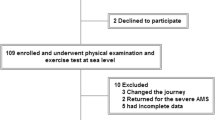Abstract
The aim of the study was to determine the factors affecting a climber’s ability to ascend Mont Blanc using a number of variables collected at the Gouter Hut (3,817 m) before and after an attempted ascent on the Mont Blanc summit. Subjects (n=285) were tested at 3,817 m prior to their ascent of Mont Blanc. Maximum height ascended in the last 14 days was recorded. End tidal CO2, arterial oxygen saturation (SaO2), heart rate and respiratory rate were measured using a Capnograph (Nellcor Patrick NPB75). Acute mountain sickness (AMS) was assessed using the Lake Louise scoring system. Summit information is available for 216 subjects. None of the subjects who attained 4,000 m in the previous 14 days failed to reach the summit (P=0.04). Previous recent exposure to an altitude of 4,000 m resulted in faster ascent times to the summit than those who had not been above 3,000 m in the previous 14 days (4.02±0.6 vs. 4.46±0.8 h, P=0.009), higher SaO2 on arrival at the Gouter Hut on day 1 (88.6±5 vs. 86.3±6%, P=0.004) and lower AMS scores upon arrival at the Gouter Hut after the attempted ascent to the summit 2.5±1.8 versus 4.7±2.5 U (P=0.001), respectively. It is concluded that recent exposure to 4,000 m confers an advantage to those who wish to ascend a 4,800 m peak.

Similar content being viewed by others
References
Aitchison TC, Sirel JM, Watt DC, MacKie RM (1995) Prognostic trees to aid prognosis in patients with cutaneous malignant melanoma. Br Med J 311:1536–1541
Fulco C, Paul B, Cymerman A (2000) Improving athletic performance: is altitude residence or altitude training helpful? Aviat Space Environ Med 71:162–171
Hackett PH, Rennie ID, Levine HD (1976) The incidence, importance, and prophylaxis of acute mountain sickness. Lancet 2:1149–1155
Lyons T, Muza S, Rock P, Cymerman A (1995) The effect of altitude pre-acclimatization on acute mountain sickness during re-exposure. Aviat Space Environ Med 66:957–962
Maggiorini M, Buhler B, Walter M, Oelz O (1990) Prevalence of acute mountain sickness in the Swiss Alps. Br Med J 301:853–855
Roach RC, Houston CS, Honigman B, Nicholas R, Yaron M, Grissom CK, Alexander JK, Hultgren HN (1995) How well do older persons tolerate moderate altitude? West J Med 162:32–36
Schneider M, Bernasch D, Weymann J, Holle R, Bartsch P (2002) Acute mountain sickness: influence of susceptibility, pre-exposure, and ascent rate. Med Sci Sports Exerc 34:1886–1891
Tsianos G, Eleftheriou K, Hawe E, Woolrich L, Watt M, Watt I, Peacock A, Montgomery H, Grant S (2005) Performance at altitude and angiotensin converting enzyme genotype. Eur J Appl Physiol 93:630–633
Acknowledgements
The authors wish to acknowledge the support given by the University of Glasgow Chancellor’s Fund and John Robertson Bequest.
Author information
Authors and Affiliations
Corresponding author
Rights and permissions
About this article
Cite this article
Tsianos, G., Woolrich-Burt, L., Aitchison, T. et al. Factors affecting a climber’s ability to ascend Mont Blanc. Eur J Appl Physiol 96, 32–36 (2006). https://doi.org/10.1007/s00421-005-0066-8
Accepted:
Published:
Issue Date:
DOI: https://doi.org/10.1007/s00421-005-0066-8




